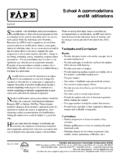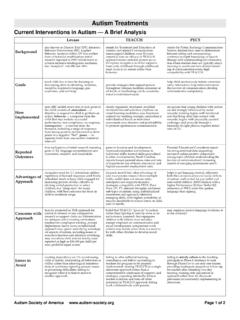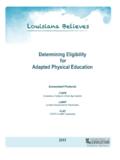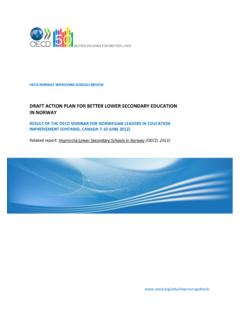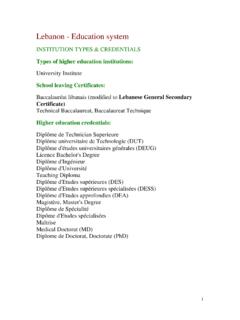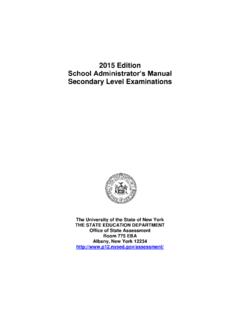Transcription of MARILYN J. BARTLETT, M.ED., P .D., J.D. - Wrightslaw
1 1 MMARILYN ARILYN J. BJ. BARTLETTARTLETT, , , P., , , Professor, Education Law Texas A& M - Kingsville Room #100, 1055 N. University Blvd. Kingsville, TX 78363 Transitioning from high school to post- secondary education: Why transition from the IEP to a 504 plan in the freshman or sophomore year is important! Students with disabilities who plan to go on in school after high school and who have an IEP or receive accommodated services in the public secondary education setting need to be advised of the transitioning process into post- secondary education. Students with disabilities are protected under IDEA 2004, Rehabilitation Act of 1973, Section 504, the Americans with Disabilities Act (ADA) and the Americans with Disabilities Act, Amended Acts of 2008 (ADA AA). Later, when the child is enrolled in a post- secondary educational setting, the protections of ADA AA will be critical. The transition process is mandated by law to begin at age 14 or in the eighth grade.
2 1. Students with special needs must be given a specific program of study leading to a standard or special diploma. a. This is where the rubber hits the road. If you and your child have post- secondary education plans in mind, you must see to it that your child receives a standard diploma. (Actually, if it is at all possible to avoid the special diploma, do so! Many low functioning positions require a high school diploma for persons with special needs!) 2. Your teenager must be given instruction or information on self-determination and advocacy. 2 a. But in my mind, age 14 or eighth grade is too late to begin! This is what the law mandates but as you know, most students with special needs, who also happen to be teenagers, need time to come around to new ideas, especially ideas suggested by their parents! You need to start with this much earlier. Set the stage when your child is younger; in general, from the time your child is six or seven, keep asking that child - When you grow up, what do you want to be, where do you want to go to college?
3 Remember - even though all teenagers are not necessarily college material it is still a good idea to talk about it until you know for sure. Plant and nurture the seeds of vocations! When the teenager is age 16, the law mandates that the IEP must include measurable post- secondary goals and transition services including courses of study that will enable your teenager to achieve her/his goals. 3. At this point, your teenager must have a pretty good idea of what they want to do and to which post- secondary institution they need to go to accomplish their life s goals! Again, to begin this process at age 16 is most likely too late for any student, let alone your teenager with special needs! And, one problem I have observed is that high school principals and guidance counselors are not advising the students regarding this transition process very well. With a growing number of students with disabilities entering a post- secondary institution setting, the need for this successful transition is necessary.
4 In 2008 2009, there were 4,470 two year and four year post- secondary degree granting institutions, out of those, 3,680 enrolled students with some type of disability, this equates to 88% of the institutions enrolled students with disabilities (Raue and Lewis, 2011, p. 5). There were approximately 3 707,000 students with some type of disability enrolled in a two-year or four-year post- secondary degree granting institution (Raue and Lewis, 2011, p. 6). So, what s a parent to do? Actually, there are several things parents need to do. Let s take some ideas one at a time. 4. This may sound silly, but, Parent, you who are reading this right now, have you discussed the fact that your teenager is disabled with your teenager? If your teenager does not understand that they have a handicapping condition, tell them! You would be amazed at how many students arrive at college, visit the personnel in the office of disabilities, present their folder of accommodations materials and break down and cry when the director says, So, you have Aspergers?
5 Or, Your materials inform me that you are learning disabled and reading on about the fifth grade level? Response: My mother never told me that (*tears*)! 5. Teach your teenager to self-advocate beginning as young as you can. a. Begin by talking with your teenager about their special gifts and talents (what do they do well) and the extent of their disability (what is difficult for them to do assisted or unassisted?) Maybe you and your teenager could make a chart so that they can see for themselves that they have special gifts and well as difficulties. b. You will probably need to teach your teenager the words to verbalize what they can and cannot do. Role-play with your teenager. If they have practiced the language, then, when put in the awkward spot, the words will be there and spoken from a position of strength, not embarrassment. c. Specifically talk to your teenager about what works well for them when they are in school or studying or traveling about what works well for them with their unique 4 disability.
6 (One size does not fit all!) Again, my friends in the office of disabilities tell me that many students arrive and have no clue which help them best. (The answer: *shrug* - head tilted, shoulder goes up, flat affectation I don know. This is when the parent looks at the 18 year old freshman and wonders, Is this my poor baby who has special needs or is this some strange teenager talking? ) 6. Establish with your teenager post- secondary plans. a. When your teenager is 12 or 13 years of age, you need to make a judgment as to whether you think your teenager can succeed in some post- secondary academic setting. Not all kids are college material, but if you and your child talk about the future beginning at six to seven years of age, then, at fourteen years, the teenager will be more willing to engage in discussions about post- secondary education. 7. When your teenager is 13 years old, you must talk about life s occupations. a. It would be helpful to look at people by defining them by what they do.
7 Kids tend not to see Uncle Bill the real estate agent as anything other than Uncle Bill! But when you point out occupations and you add self-efficacy statement, You could do that! it may just begin to sink in. You have to do it consistently .. for years! (That s why you ll start when your child is still a child!) School personnel do not have the time to engage in discussions about what each teenager could be when they grow up. It is haphazard at best for regular kids, usually non-existent for kids with special needs. Once again, you need to do your teenager can begin to envision them self as the lawyer, the teacher, the fireman, or even a chef! Now this is where you must understand the law. 5 8. When your teenager is 14 or in the eighth grade, you need to ask about what the school has planned for beginning transition to the post- secondary education. Having done your homework, you will have an agenda of what you and your teenager want to have happen. a. A part of your homework is knowing which schools are appropriate for your teenager.
8 Consider Beacon College in Florida or Landmark College in Vermont. Both are strictly for learning disabled students. You need to research the institution s office of disabilities to determine if the facility is handicapped friendly. You may want to use the Ohio State University as the high-end benchmark and compare other schools to Ohio State. b. Be prepared to transition your teenager off the IEP and onto a 504 plan. Too many students with disabilities do not understand the importance of their IEP, the need to transition to a 504 Plan prior to graduating high school, and their rights under the ADA AA in the post- secondary environment. c. Assuming that your teenager is capable of succeeding in a post- secondary educational setting, now is the time to make sure your child is taking the right courses required to get into that setting. i. Request a meeting with your child s guidance counselor to discuss the academic program and its relation to further education, employment, and independent living.
9 (The purpose of IDEA 2004 - 20 USC 1400(d)) Do your homework and know which college-prep courses the post- secondary school would like your child to have taken. You can help ensure that the guidance counselor will include those classes with appropriate accommodations. If possible, have your child attend this meeting and be the self-advocate along with you. 6 ii. Again, assuming that your child is still on an IEP, at age 15 it is time to begin to wean the child off the special education prescriptive program. An IEP is akin to a prescription with treatment we have diagnosed the difficulty, we have prescribed remediation training, we also are providing support services, etc, etc. versus, being on a 504 plan that simply contains accommodations - in order to level the playing field. There comes a point at the end of the freshman year or beginning of the sophomore year when perhaps it is more important to have your child attending all classes for the content rather than being pulled out to work on skills associated with their IEP.
10 In addition, this is about the time when your child will tell you that they don t want to be different they just want to be a regular teenager. It is no longer effective to be pulling your child out of classes for some remedial work thereby causing them to miss the history lecture or the introduction to the newest algebra concept upon which next week s test will be based! At this point, it would be better for your child to begin to experiment with different types of accommodations for the next two years (maybe five semesters) to determine what works and what doesn t work for her/him while they are still in high school and maybe having a tutor after school. 9. But wait! First get your ducks lined up! You need to review what happens when you take your child off the IEP. Before you allow your child to come off the IEP, ask for an evaluation; if the school refused, ask for an Independent Educational Evaluation (IEE - 20 USC 1415(b)(1)). By the middle of the sophomore year, when your child is 15 years and 6 months, you need to have the school district pay for one more full evaluation.
